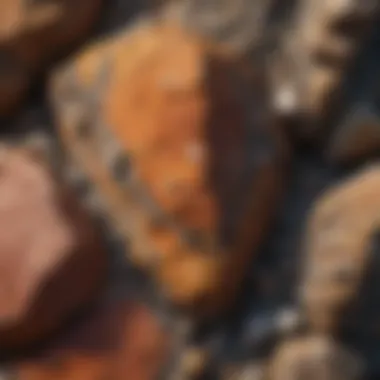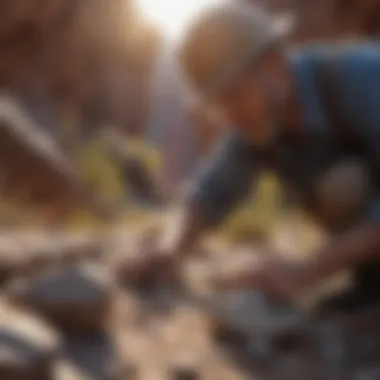Unlocking the Wonders of Rock Hardness with a Comprehensive Kit


Rock and Fossil Identification
In the realm of rock and fossil identification, a key aspect lies in discerning the various types of rocks and fossils that exist in nature. These geological treasures display a diverse array of characteristics, each offering valuable insights into Earth's history. When embarking on the journey of rock and fossil identification, enthusiasts must pay close attention to distinct features that set each specimen apart. By scrutinizing textures, colors, and patterns, collectors can unveil hidden clues about the origins and composition of these ancient formations. Accompanying this visual analysis, utilizing specialized tools for identification enhances the precision and accuracy of categorizing rocks and fossils, enabling a deeper understanding of their geological significance.
Collecting Tips and Techniques
Venturing into the realm of rock and fossil collecting demands adherence to best practices and techniques to ensure a fruitful and respectful approach to the Earth's treasures. Delving into prime collecting sites holds the promise of encountering exceptional specimens waiting to be unearthed. Locating these sites requires a blend of research, exploration, and a keen eye for geological formations. Furthermore, extracting specimens from their natural habitats necessitates a delicate touch and meticulous care to preserve their integrity and beauty. By adopting safe and sustainable collection methods, enthusiasts can treasure their discoveries while upholding the preservation of our planet's geological heritage.
Preservation and Display
Preservation stands as a crucial pillar in safeguarding the longevity and allure of collected rocks and fossils. Employing techniques such as fossil casting, rock coating, or embedding fossils in resin ensures their protection from environmental factors and decay, allowing future generations to marvel at these ancient artifacts. Effective storage methods play a pivotal role in maintaining the stability and condition of specimens, safeguarding them from deterioration over time. When it comes to showcasing these geological wonders, exploring creative display ideas adds a layer of artistry and storytelling to the presentation, capturing the imagination of onlookers and imparting the rich history encapsulated within each rock and fossil.
Geological Insights
Delving deeper into the geological realm unveils the fascinating interplay between Earth's formations and the processes that have shaped them over millennia. By studying geological formations and processes, enthusiasts unravel the intricate tapestry of Earth's history, gaining profound insights into the forces that have sculpted our planet. Additionally, exploring the historical significance of rocks and fossils illuminates the narratives of ancient life forms and past environments, offering a glimpse into the dynamic evolution of our planet. Notable discoveries in the field serve as testaments to human curiosity and scientific perseverance, marking milestones in our understanding of Earth's geological past.
Prologue to Rock Hardness
Rock hardness serves as a critical aspect in the realm of geology, shedding light on the durability and resistance of various rock formations. Understanding the intricacies of rock hardness is paramount as it impacts geological surveys, mineral identification, and overall comprehension of Earth's composition. By delving into the concept of rock hardness, individuals open themselves to a world of knowledge that transcends mere physical attributes. This section will initiate a comprehensive exploration into the depths of rock hardness, unearthing its significance and practical implications.
Understanding Mohs Scale
The Mohs scale, a fundamental tool in the study of rock hardness, provides a standardized framework for assessing the hardness of minerals based on their scratch resistance. A key characteristic of the Mohs scale lies in its simplicity and applicability, making it a popular choice for geologists and mineralogists alike. Its unique feature of assigning hardness levels from 1 to 10 enables seamless comparison and categorization of minerals, aiding in mineral identification and classification within the geological community.
Common minerals at each level
Examining common minerals at various levels of the Mohs scale offers invaluable insights into the diverse range of hardness exhibited in nature. By highlighting minerals such as talc at level 1 and diamond at level 10, individuals can grasp the vast spectrum of hardness that exists within the Earth's crust. Understanding the prevalence of certain minerals at specific hardness levels serves as a foundational element in mineral analysis and aids in distinguishing between different rock types based on their hardness characteristics.


Significance of Rock Hardness
The significance of rock hardness extends beyond mere academic interest, influencing various facets of geology and mineralogy. Its profound impact on geological formations, mineral formations, and erosion processes underlines the intricate connection between hardness levels and geological behaviors. By recognizing the role of rock hardness in shaping Earth's landscapes, geologists can decipher clues about past geological events and predict future geological developments with enhanced precision.
Impact on geology and mineralogy
The impact of rock hardness on geology and mineralogy transcends theoretical knowledge, shaping practical applications in resource exploration, mining operations, and environmental assessments. By understanding how hardness influences the formation and distribution of minerals, geologists can make informed decisions regarding mineral extraction, land use planning, and conservation strategies. Rock hardness stands as a vital parameter in geological research, facilitating a deeper comprehension of Earth's geological processes and history.
Practical applications
The practical applications of rock hardness span a wide range of industries, from construction and engineering to archaeology and gemology. By harnessing the knowledge of rock hardness, professionals can select appropriate materials for building foundations, design durable structures, and extract valuable minerals with efficiency. The versatility of rock hardness data enables researchers to innovate in materials science, enhance infrastructure development, and preserve precious geological specimens for future generations.
Introducing Rock Hardness Kits
Rock hardness kits provide enthusiasts with a comprehensive toolkit for exploring the fascinating world of geological hardness levels. By examining the components of a rock hardness kit, individuals gain access to essential tools such as hardness picks, mineral specimens, and testing surfaces that enhance their understanding of rock hardness. The usage instructions included in rock hardness kits offer clear guidance on conducting hardness tests, distinguishing between various hardness levels, and interpreting results effectively.
Components of a rock hardness kit
The components of a rock hardness kit typically consist of hardness picks, a testing plate, and a variety of mineral samples ranging in hardness levels. These elements empower enthusiasts to perform scratch tests, hardness experiments, and mineral identification tasks with precision and accuracy. Each component plays a crucial role in elucidating the complexities of rock hardness, providing hands-on experience and practical insights into the world of geological science.
Usage instructions
Accompanying every rock hardness kit are usage instructions designed to assist individuals in conducting hardness tests and interpreting results accurately. By following step-by-step guidelines, users can navigate through hardness testing procedures, record their observations, and compare hardness levels across different mineral samples. The usage instructions embedded in rock hardness kits serve as invaluable resources for beginners and experienced geologists alike, promoting a deeper engagement with the field of mineralogy and geology.
Exploring Rock Hardness Levels
In this article, we embark on a journey deep into the realm of rock hardness levels, a critical aspect in the study and appreciation of rocks. Understanding the various levels of rock hardness is essential for rock and fossil collectors as it provides valuable insight into the composition, durability, and geological significance of different rock types. By delving into soft, medium-hard, and hard rocks on the Mohs scale, we unravel the diverse characteristics and properties that make each category unique. Exploring rock hardness levels is not just an academic exercise; it is a practical tool for enthusiasts to identify, categorize, and appreciate the rocks they encounter in their geological explorations.
Soft Rocks (Mohs Scale 1-3)


Characteristics of soft rocks: Soft rocks on the Mohs scale exhibit low hardness levels, making them vulnerable to scratching and abrasion. Despite their susceptibility to damage, soft rocks possess a smooth texture and are often characterized by high mineral content. Their softness facilitates easy carving and shaping, making them popular among artists and craftsmen for sculptures and ornaments. While their soft nature may limit their use in structural applications, soft rocks are valued for their aesthetic appeal and artistic versatility.
Examples of rocks in this category: Common examples of soft rocks include talc, gypsum, and calcite. These rocks are prevalent in sedimentary environments and are often associated with deposits rich in organic matter. Soft rocks play a crucial role in mineral formation and can provide insights into past environmental conditions. Despite their delicate nature, soft rocks offer a window into the geological history of an area, highlighting the intricate processes that have shaped the Earth over millennia.
Medium Hard Rocks (Mohs Scale 4-6)
Distinguishing features of medium hard rocks: Medium hard rocks exhibit moderate hardness levels on the Mohs scale, striking a balance between durability and workability. These rocks are less susceptible to abrasion than soft rocks and often feature distinct cleavage planes that aid in their identification. Medium hard rocks like fluorite and feldspar showcase vibrant colors and unique crystal structures prized by collectors and researchers alike. Their versatility in jewelry making, construction, and industrial applications makes medium hard rocks indispensable in various fields.
Prominent rock specimens: Notable examples of medium hard rocks include quartz, orthoclase, and apatite. These rocks are renowned for their beauty and durability, offering a blend of aesthetics and resilience. Medium hard rocks play a vital role in geological formations, acting as key indicators of mineral deposits and geological processes. Their presence in nature signifies the intricate interplay of physical and chemical forces that have shaped the Earth's crust over millions of years.
Hard Rocks (Mohs Scale 7-10)
Properties of hard rocks: Hard rocks exhibit high levels of hardness on the Mohs scale, making them resistant to wear and erosion. These rocks are characterized by their durability, strength, and often lustrous appearance. Hard rocks like diamond and corundum are sought after for their use in cutting tools, abrasives, and gemstones due to their exceptional hardness and resilience. The impenetrable nature of hard rocks reflects the intense geological processes that have led to their formation and preservation over geological time scales.
Highly resilient minerals: Minerals found in hard rocks such as diamond and topaz showcase exceptional resilience and optical properties that set them apart from other gemstones. These minerals are prized for their rarity, brilliance, and symbolic significance across different cultures. Despite their high hardness, these minerals are not impervious to external forces and may exhibit cleavage or fracture under extreme pressure conditions. Understanding the unique properties of highly resilient minerals enhances our appreciation for the intricate processes that govern mineral formation and transformation in the Earth's crust.
Benefits of Using Rock Hardness Kits
Rock hardness kits play a pivotal role in facilitating our understanding of geology and mineralogy. By utilizing these kits, enthusiasts and researchers can delve into the intricate world of rock hardness measurement, gaining valuable insights into the properties and composition of different rocks across various hardness levels. The significance of utilizing rock hardness kits extends beyond mere academic learning; it enables individuals to apply their knowledge practically in fields such as geology, mineralogical surveys, and even casual rock collection. Embracing the use of rock hardness kits elevates one's comprehension of rocks from a theoretical concept to a tangible and interactive experience, fostering a deeper connection with the Earth's composition and history.
Educational Purposes
- Enhancing Learning Experiences:
Amplifying the learning process, rock hardness kits offer a hands-on approach to comprehending geological concepts. By interacting directly with the tools and samples provided in these kits, learners can grasp the nuances of rock hardness more effectively. This experiential learning fosters a deeper understanding and retention of information compared to traditional theoretical study methods. The interactive nature of rock hardness kits not only engages the learner but also encourages exploration and experimentation, enabling a more holistic understanding of the subject matter.
- Hands-on Exploration:


Hands-on exploration within the realm of rock hardness kits instills a sense of curiosity and discovery in enthusiasts. This mode of exploration allows individuals to engage all their senses, from observing the visual characteristics of rocks to feeling their textures and testing their hardness levels. The tactile nature of hands-on exploration deepens the learning experience, making it more immersive and memorable. Moreover, this interactive approach encourages individuals to ask questions, seek answers through experimentation, and develop a genuine passion for understanding the geological processes that shape our planet.
Field Applications
- Geological Surveys:
Rock hardness kits serve as indispensable tools during geological surveys, aiding geologists and researchers in identifying and classifying rock specimens. Through the use of these kits, surveyors can collect accurate data on rock hardness, which is crucial for mapping geological formations and understanding the structural composition of the Earth's crust. The portability and adaptability of rock hardness kits make them essential companions for fieldwork, enabling scientists to make real-time observations and draw insightful conclusions based on their findings.
- Identification of Minerals:
In the realm of mineral identification, rock hardness kits provide a systematic approach to distinguishing various minerals based on their hardness levels. By utilizing testing tools and guidelines included in these kits, mineralogists can categorize minerals efficiently, streamlining the identification process. The clear procedures outlined in rock hardness kits help researchers avoid misattributions and ensure accurate mineral classification, essential for conducting precise analyses and drawing valid scientific conclusions.
Hobbyist Use
- Collecting and Categorizing Rocks:
For hobbyists and rock collectors, the use of rock hardness kits enhances the joy of rock collecting by introducing a structured methodology to categorize and organize rock specimens. These kits enable enthusiasts to differentiate rocks based on their hardness levels, adding a new dimension to their collection practices. By systematically categorizing rocks using the Mohs scale, collectors can curate their displays more thoughtfully and engage in educational activities that deepen their appreciation for the geological diversity present in various rock formations.
- Understanding Geological Differences:
By using rock hardness kits, hobbyists can gain a nuanced understanding of the geological variances present in different rock types. The process of testing and comparing the hardness of various rocks enhances hobbyists’ awareness of the geological processes that shape rock formations. This hands-on approach allows enthusiasts to discern the unique characteristics of rocks, appreciate the environmental factors that influence rock hardness, and develop a nuanced understanding of the Earth's geological history.
Culmination
Exploring the nuances of rock hardness levels with a rock hardness kit unveils a realm of geological significance essential for enthusiasts and professionals alike. In this comprehensive guide, we have delved into the diverse spectrum of rock hardness, from soft rocks at Mohs Scale 1-3 to the resilient hard rocks at Mohs Scale 7-10. Understanding rock hardness not only aids in mineral identification but also plays a pivotal role in geological surveys and educational experiences. The practical applications of rock hardness kits offer a hands-on approach to learning about geological differences and mineral characteristics, enriching the exploration of Earth's composition.
Wrapping Up Insights
Key takeaways on rock hardness
Discussing the key takeaways on rock hardness encapsulates the essence of this article, emphasizing the crucial role of hardness levels in the classification and identification of rocks. By grasping the differentiation between soft, medium-hard, and hard rocks, enthusiasts can enhance their understanding of geological compositions and mineral properties. The comprehensive nature of rock hardness assessment provides a detailed insight into the resistance of rocks to abrasion and external factors, aiding in categorizing specimens accurately. Rock hardness kits serve as indispensable tools for enthusiasts, offering a practical means of exploring the physical attributes of various minerals and rocks, thus fostering a deeper appreciation for Earth's geological diversity.
Implications for rock enthusiasts
Analyzing the implications for rock enthusiasts sheds light on the practical benefits of rock hardness exploration. By immersing themselves in the study of hardness levels, enthusiasts gain valuable knowledge that can be applied in various facets of rock collecting and mineral identification. Understanding the implications of rock hardness extends beyond mere observation, enabling enthusiasts to interpret geological formations and appreciate the resilience of different rocks and minerals. This awareness enhances the overall experience of rock enthusiasts, empowering them to make informed decisions when acquiring specimens and expanding their geological expertise. The implications of rock hardness for enthusiasts underscore the intricate relationship between mineral properties, geological processes, and the dynamic nature of Earth's crust.







